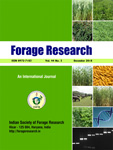LOKESH KUMAR JAT*, HARPHOOL SINGH, Y. V. SINGH1, HANUMAN SINGH JATAV, INDUBALA SETHI, HANSRAM MALI AND N. K. BAROD
Rajasthan Agricultural Research Institute (SKN Agriculture University, Jobner), Durgapura, Jaipur-302 018 (Rajasthan), India
Department of Soil Science & Agril. Chemistry, Institute of Agricultural Sciences, Banaras Hindu University, Varanasi-221 005 (U.P.), India
Krishi Vigyan Kendra (SKN Agriculture University, Jobner), Navgaon, Alwar-301 025 (Rajasthan), India
*(e-mail: ljatlkjat.soils@sknau.ac.in)
(Received : 2 May 2025; Accepted : 29 June 2025)
SUMMARY
Field experiments were conducted for two years on a sandy loam soil at Agricultural Research Farm, Institute of Agricultural Sciences, Banaras Hindu University, Varanasi, Uttar Pradesh to assess the effects of combined application of organics with chemical fertilizers on concentration and uptake of major nutrients in rice-wheat cropping system on Alluvial soils of Varanasi. The experiment was laid out in randomized block design (RBD) with nine treatments comprised control (no fertilizer), 100% NPK and seven combinations of 70% NPK with different organics viz., FYM, pressmud and vermicompost. The treatments were applied in rice and the residual effect of treatments was evaluated in subsequent wheat crop in the sequence and the cycle repeated twice. The result revealed that the substitution of 30% N by pressmud and FYM equally is significantly improved the yields, concentration of macro nutrients in rice and the residual effect also found significant in wheat. Application of 70% RDF + 30% N through FYM and pressmud recorded maximum yield of grain as 4.90 t/ha in rice and 4.20 t/ha in wheat, highest concentration of N (1.30 & 0.69%), P (0.35 & 0.34%), Cu (7.82 & 16.84 ppm), Mn (15.64 & 53.99 ppm) in grains and straw, respectively of rice crop. Meanwhile, the higher concentration of K and S recorded in other treatment combinations. In wheat crop, the highest uptake of N (63.59 & 51.25 kg/ha), P (17.25 & 25.17 kg/ha), K (17.67 & 104.56 kg/ha) and S (18.17 & 29.10 kg/ha) by grains and straw of rice, respectively was recorded with application of 70% RDF + 30% N by FYM. Similar residual effect in terms of concentration and uptake of nutrients was also reported in subsequent wheat crop during both the years.
Key words: Alluvial soil, integration, nutrition, Oryza sativa, Triticum aestivum and yield

